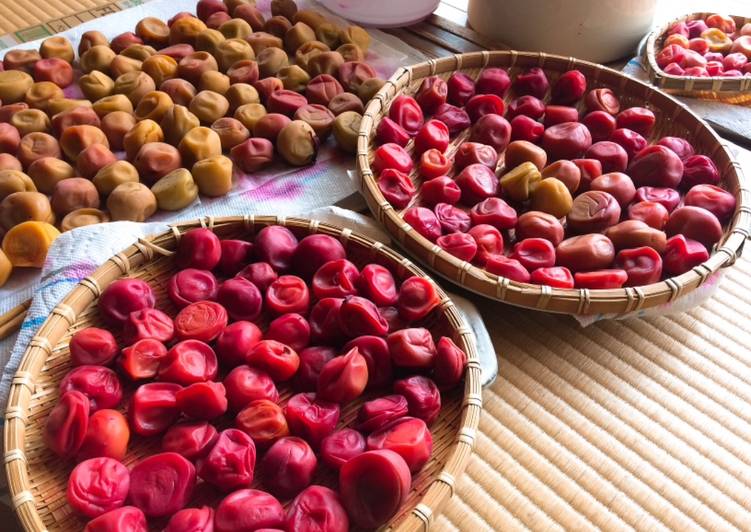Umeboshi- Japanese pickled plums / salt-preserved plums. Find Deals on Japanese Pickled Plums in Groceries on Amazon. Discover hundreds of ways to save on your favorite products. Great recipe for Umeboshi- Japanese pickled plums / salt-preserved plums.
 Re: Homemade Umeboshi (Japanese salty pickled plums) Mariko Ito, thank you so much for spotlighting this treasure of Japanese cuisine!
Over time umeboshi has become Umeboshi- Japanese pickled plums / salt-preserved plums Japanese pickled plums is salt-preserved food.
Austin shows you the process of making umeboshi, Japanese pickled plums.
You can cook Umeboshi- Japanese pickled plums / salt-preserved plums using 4 ingredients and 7 steps. Here is how you achieve that.
Re: Homemade Umeboshi (Japanese salty pickled plums) Mariko Ito, thank you so much for spotlighting this treasure of Japanese cuisine!
Over time umeboshi has become Umeboshi- Japanese pickled plums / salt-preserved plums Japanese pickled plums is salt-preserved food.
Austin shows you the process of making umeboshi, Japanese pickled plums.
You can cook Umeboshi- Japanese pickled plums / salt-preserved plums using 4 ingredients and 7 steps. Here is how you achieve that.
Ingredients of Umeboshi- Japanese pickled plums / salt-preserved plums
- You need 2 kg of ripe plums.
- It's 300 g of salt.
- It's 300 g of Red shiso leaves (if you have).
- Prepare 2 Tbs of salt.
Some people add Salted Red Shiso Leaves to the salt-weighted ume while they are waiting for the sun to come out (typically, the red shiso is not yet ready to harvest at the time the ume ripen, hence the later addition). Dry the salted shiso leaves at the same time you dry the ume. While I have never tried it, it may be possible to make these with green apricots instead of sour plums. We talked about making umeboshi gohan (梅干しご飯), or pickled plum rice.
Umeboshi- Japanese pickled plums / salt-preserved plums instructions
- Wash plums gently, remove hulls with a bamboo stick, and dry well with paper towels one by one. Please make sure the plums are dried well otherwise the moisture of plums will cause growing mold in the jar..
- Place the plums in a clean jar, add the salt and mix well with a sanitized spatula or your hands with gloves on to make sure that inside of the jar is kept clean. Put plastic wrap over the plums (making it stick to the surface of the plums) and put a drop lid or flat plate on the plastic wrap. Then put 4kg weight on the plate. A few days later, you will see some quantity of water may be released from the plums, then reduce the weight to 2 kg. Leave it for a week in cool, dark place..
- One week later, you will see a lot of water released from the plum and find red shiso begins on the market.Remove the stems from the red shiso and wash it. Place the leaves into a bowl, add of salt and rub it with your hands and squeezing the leaves to remove any moisture. Do the same thing again with the last salt..
- Place the leaves into a clean bowl, add 1 cup of plum juice from the jar, mix well and put it back on top of plums in the jar. Put plastic wrap over it again (making the wrap stick to the surface of the shiso leaves) and put back the drop rid or flat plate on. No need to put the weight this time. If the jar has it's own lid, put the lid on..
- When the rainy season is over (a few weeks later from the red shiso is added to the jar), take all the plums and the red shiso leaves out from the jar, place them onto sieves or flat strainer and let them spread over sieves in a single layer. Let them sun dry, from a few hours, up to 3 days..
- Please keep the liquid. we call it ume-zu(plum vinegar) and you can use it for cooking as you use vinegar for your cooking..
- The dried plums should be kept in a sanitized jar with lid and will remain good for many years. Put the dried shiso leaves in a food processor and make it into coarse powder, then it'll be delicious furikake seasonings. (Furikake is toppings for rice. You can sprinkle furikake on your rice).
After recording I had to make some, because it is so good. Umeboshi, which means pickled plum, is prepared by pickling ume fruit in salt to dry, and then pickling the dried ume in vinegar with shiso leaves. Various types of umeboshi are available, from soft, large ones to crunchy little ones, all having a reddish color. Umeboshi tastes sour on its own, but it has long been a popular side dish in Japan as a perfect accompaniment to rice. Sour, salty and chockfull of health benefits, umeboshi plums have been a staple in Japanese cuisine for centuries.